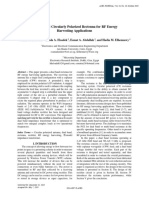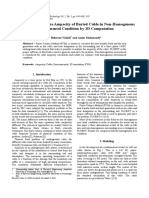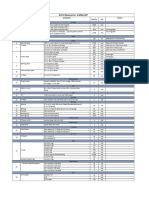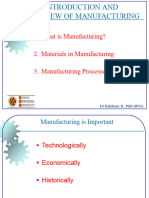Product Environmental Profile: Canalis KNA 40A To 160A
Product Environmental Profile: Canalis KNA 40A To 160A
Uploaded by
Javier LazoCopyright:
Available Formats
Product Environmental Profile: Canalis KNA 40A To 160A
Product Environmental Profile: Canalis KNA 40A To 160A
Uploaded by
Javier LazoOriginal Title
Copyright
Available Formats
Share this document
Did you find this document useful?
Is this content inappropriate?
Copyright:
Available Formats
Product Environmental Profile: Canalis KNA 40A To 160A
Product Environmental Profile: Canalis KNA 40A To 160A
Uploaded by
Javier LazoCopyright:
Available Formats
Product
Environmental
Profile
Canalis KNA 40A to 160A
ENVPEP061105EN / PEP ecopassport SCHN-2015-068
Product Environmental Profile – PEP
Product overview
Canalis KNA is designed for low power distribution up to 160A. It can be used as the main power supply for type
KDP, KBA, or KBB Lighting Busbar Trunking systems.
The Functional Unit: The function of the Canalis KNA 40A to 160A product range is to distribute electrical energy
for low power applications at Industrial buildings, Commercial centres, Tertiary buildings etc for 20 years.
Technical characteristics of Canalis KNA:
• Length of busbar trunking components: 1.5m and 3m
• Rated busbar trunking current: 40 to 160A
• Rated tap off units current: 16 to 63A
• Rated insulating voltage: 500V
• Number of active conductors: 4 + PE
• Protection index: IP55
• Surface treatment: white RAL9001
• Regulations: compliant with IEC 60439-2
This range consists of KNA, 40 A to 160 A, IP41/IP54.
The representative product used for the analysis is the typical product, Canalis KNA 63A, which consists of:
• 1 x 63 A power feed box (cat. no. KNA63AB4)
• 6 x 3 m straight lengths, 1 m modules for tap-off units (cat. no. KNA63ED4303)
• 8 connectors (cat. no. KNB25CF5)
• 7 fixing devices (cat. no. KNB160ZF1)
ENVPEP061105EN / PEP ecopassport SCHN-2015-068 Published by: Schneider Electric 08-2015
Product Environmental Profile – PEP
Lists of functions included in the configuration
Product
Description & Size (mm) Qty Device Device Function
Number
End Feed units are
equipped with a mechanical
and electrical locating
system (polarisation),
End Feed Unit
making it possible to supply
Aluminium Busbar
END FEED UNIT 63 A a run from the right or the
1. KNA63AB4 1 Trunking
A x D x E = 265 x 71 x 92 left. They are supplied with
3L + N + PE Polarity
an end cover. They can be
Right or left mounting
mounted at the end of a
line. These units are made
of moulded plastic 63A
rating.
These components Carry
Straight Length with
the current and supply low-
Tap-Off Outlets
power loads. Straight
STRAIGHT LENGTH 63 A Aluminium Busbar
2. KNA63ED4303 6 lengths constitute the basic
L x W x H = 3000 x 27.5 x 92 Trunking
structure of the line.
3L + N + PE Polarity
Equipped with 4 live
Number of outlets is 3
conductors.
These tap-off units are
used to supply loads from
16 to 63A or protect nearby
Four-Pole Tap-off unit loads against overloads
TAPOFF UNIT 25A FOR NF 3L + N + PE Polarity due to lightning strikes. Can
3. KNB25CF5 FUSES 8 Cable clamp terminals be equipped with fuse
A x B x F = 103 x 74.5 x 130 Connection holders. Disconnection by
Fuse Protection unplugging the tap-off unit.
Type of Fuse: NF 10 x 38,
(Type gG: 20 A max.
Type aM: 25 A max.)
The fixing system ensures
that Canalis KN is well
Fixing System secured, whatever the type
of building structure. These
KN FIXING BRACKETS 40A
Suspended on M8 brackets are used to
4. KNB160ZF1 TO 100A 7
threaded rod mounting suspend the KN busbar
L x W x H = 61 x 23 x 118
trunking line to the structure
40A to 160A Ratings of the building via threaded
rods M8 and do not require
tools.
The environmental impacts of this referenced product are representative of the impacts of the other products of the
range which are developed with a similar technology.
The environmental analysis was performed in conformity with ISO 14040 “Environmental management: Life cycle
assessment – Principle and framework”.
This analysis takes the stages in the life cycle of the product into account.
ENVPEP061105EN / PEP ecopassport SCHN-2015-068 Published by: Schneider Electric 08-2015
Product Environmental Profile – PEP
Constituent materials
The mass of the Canalis KNA 40A to 160A product range is from 30000 g and 40000 g including packaging. It is
37451.3 g including packaging for the typical product, Canalis KNA 63A. The constituent materials are distributed
as follows:
D:\documents and
Settings\ebbh975\My Documents\a- E
Substance assessment
Products of this range are designed in conformity with the requirements of the European RoHS Directive
2011/65/EU and do not contain, or only contain in the authorised proportions, lead, mercury, cadmium, hexavalent
chromium or flame retardants (polybrominated biphenyls - PBB, polybrominated diphenyl ethers - PBDE) as
mentioned in the Directive
Details of ROHS and REACH substances information are available on the Schneider-Electric Green Premium
website . (http://www2.schneider-electric.com/sites/corporate/en/products-services/green-premium/green-premium.page )
Manufacturing
The Canalis KNA 40A to 160A product range is manufactured at a Schneider Electric production site on which an
ISO14001 certified environmental management system has been established.
Distribution
The weight and volume of the packaging have been optimized, based on the European Union's packaging
directive.
The Canalis KNA 40A to 160A packaging weight is 4163.9 g. It consists of Paper 174.2 g, Cardboard 2379.5 g and
Wood 1610.2 g.
The product distribution flows have been optimised by setting up local distribution centres close to the market
areas.
ENVPEP061105EN / PEP ecopassport SCHN-2015-068 Published by: Schneider Electric 08-2015
Product Environmental Profile – PEP
Use
The products of the Canalis KNA 40A to 160A range do not generate environmental pollution (noise, emissions)
requiring special precautionary measures in standard use.
The dissipated power depends on the conditions under which the product is implemented and used. This
dissipated power is between 0 W and 300 W for the Canalis KNA 40A to 160A product range. It is 154 W at 30%
load in Active mode and 0 W in OFF mode for the typical product, Canalis KNA 63A, referenced, i.e. 8.6 W/metre.
This thermal dissipation represents less than 0.2% of the power which passes through the product.
The product range does not require special maintenance operations.
End of life
At end of life, the products in the Canalis KNA 40A to 160A have been optimized to decrease the amount of waste
and allow recovery of the product components and materials.
This product range doesn’t need any special end-of-life treatment. According to countries’ practices this product
can enter the usual end-of-life treatment process.
The recyclability potential of the products has been evaluated using the “ECO DEEE recyclability and recoverability
calculation method” (version V1, 20 Sep. 2008 presented to the French Agency for Environment and Energy
Management: ADEME).
According to this method, the potential recyclability ratio without packaging is: 89%.
As described in the recyclability calculation method this ratio includes only metals and plastics which have proven
industrial recycling processes.
Environmental impacts
Life cycle assessment has been performed on the following life cycle phases: Materials and Manufacturing (M),
Distribution (D), Installation (I) Use (U), and End of life (E).
Modeling hypothesis and method:
- The calculation was performed on Canalis KNA 40A to 160A.
- Product packaging is included.
- Installation components: No special components included.
- Scenario for the Use phase: This product range is included in the category “Energy passing
product”. Assumed service lifetime is 20 years and use scenario is: Product dissipation is 154 W at
30% load in Active mode and 0 W in OFF mode, loading rate is 30%, service uptime is 30% and
service Off time is 70%.
- The geographical representative area for the assessment is EUROPEAN and the electrical power
model used for calculation is Europe model.
- End of life impacts are based on a worst case transport distance to the recycling plant (1000km)
ENVPEP061105EN / PEP ecopassport SCHN-2015-068 Published by: Schneider Electric 08-2015
Product Environmental Profile – PEP
Presentation of the product environmental impacts
Environmental indicators Unit For Canalis KNA 63A
S=M+D
M D I U E
+I+U+E
Air Acidification (AA) kg H+ eq 1.07E+00 2.81E-02 1.21E-03 0.00E+00 1.03E+00 5.33E-03
Air toxicity (AT) m³ 1.25E+09 4.04E+07 1.80E+06 0.00E+00 1.20E+09 7.94E+06
Energy Depletion (ED) MJ 1.01E+05 3.04E+03 9.05E+01 0.00E+00 9.70E+04 3.83E+02
Global Warming Potential (GWP) kg CO₂ eq. 5.01E+03 1.83E+02 6.44E+00 0.00E+00 4.79E+03 2.72E+01
Hazardous Waste Production
kg 7.30E+00 6.48E+00 7.95E-06 0.00E+00 8.22E-01 3.36E-05
(HWP)
kg CFC-11
Ozone Depletion Potential (ODP) 1.10E-03 1.15E-05 1.22E-08 0.00E+00 1.09E-03 5.15E-08
eq.
Photochemical Ozone Creation kg C₂H₄
3.52E-01 4.70E-02 1.66E-03 0.00E+00 2.96E-01 6.76E-03
Potential (POCP) eq.
Raw Material Depletion (RMD) Y-1 5.08E-13 4.43E-13 1.31E-16 0.00E+00 6.46E-14 5.55E-16
Water Depletion (WD) dm3 1.36E+04 1.15E+03 6.67E-01 0.00E+00 1.25E+04 2.82E+00
kg PO₄³⁻
Water Eutrophication (WE) 5.95E-02 1.39E-02 1.19E-05 0.00E+00 4.56E-02 5.05E-05
eq.
Water Toxicity (WT) m³ 2.19E+03 4.25E+01 2.75E+00 0.00E+00 2.13E+03 1.16E+01
Life cycle assessment has been performed with the EIME software (Environmental Impact and Management
Explorer), version 5 and with its database version 2013-02
The USE (U) phase is the life cycle phase which has the greatest impact on the majority of environmental
indicators. The manufacturing phase is responsible for the major impacts on the Raw Material Depletion (RMD) as
well as on the Hazardous Waste Production (HWP).
According to this environmental analysis, proportionality rules may be used to evaluate the impacts of other
products of this range: “Depending on the impact analysis, the environmental indicators (without RMD and HWP) of
other products in this family may be proportional extrapolated by energy consumption values”. For RMD and HWP,
impact may be proportional extrapolated by mass of the product.
System approach
As the products of the range are designed in accordance with the European RoHS Directive 2011/65/EU, they can
be incorporated without any restriction in an assembly or an installation subject to this Directive.
Please note that the values given above are only valid within the context specified and cannot be used directly to
draw up the environmental assessment of an installation.
ENVPEP061105EN / PEP ecopassport SCHN-2015-068 Published by: Schneider Electric 08-2015
Product Environmental Profile – PEP
Glossary
Air Acidification (AA) The acid substances present in the atmosphere are carried by rain. A high level of acidity in the rain
can cause damage to forests. The contribution of acidification is calculated using the acidification
potentials of the substances concerned and is expressed in mode equivalent of H+.
Air Toxicity (AT) This indicator represents the air toxicity in a human environment. It takes into account the usually
accepted concentrations for several gases in the air and the quantity of gas released over the life
cycle. The indication given corresponds to the air volume needed to dilute these gases down to
acceptable concentrations.
Energy Depletion (ED) This indicator gives the quantity of energy consumed, whether it is from fossil, hydroelectric, nuclear or
other sources. It takes into account the energy from the material produced during combustion. It is
expressed in MJ.
Global Warming (GW) The global warming of the planet is the result of the increase in the greenhouse effect due to the
sunlight reflected by the earth’s surface being absorbed by certain gases known as "greenhouse-
effect" gases. The effect is quantified in gram equivalent of CO2.
Hazardous Waste Production (HWP) This indicator quantifies the quantity of specially treated waste created during all the life cycle phases
(manufacturing, distribution and utilization). For example, special industrial waste in the manufacturing
phase, waste associated with the production of electrical power, etc. It is expressed in kg.
Ozone Depletion (OD) This indicator defines the contribution to the phenomenon of the disappearance of the stratospheric
ozone layer due to the emission of certain specific gases. The effect is expressed in gram equivalent
of CFC-11.
Photochemical Ozone Creation (POC) This indicator quantifies the contribution to the "smog" phenomenon (the photochemical oxidation of
certain gases which generates ozone) and is expressed in gram equivalent of ethylene (C2H4).
Raw Material Depletion (RMD) This indicator quantifies the consumption of raw materials during the life cycle of the product. It is
expressed as the fraction of natural resources that disappear each year, with respect to all the annual
reserves of the material.
Water Depletion (WD) This indicator calculates the volume of water consumed, including drinking water and water from
industrial sources. It is expressed in dm3.
Water Eutrophication (WE) Eutrophication is a natural process defined as the enrichment in mineral salts of marine or lake waters
or a process accelerated by human intervention, defined as the enrichment in nutritive elements
(phosphorous compounds, nitrogen compounds and organic matter). This indicator represents the
water Eutrophication of lakes and marine waters by the release of specific substances in the effluents.
It is expressed in grams equivalency of PO43-(phosphate).
Water Toxicity (WT) This indicator represents the water toxicity. It takes into account the usually accepted concentrations
for several substances in water and the quantity of substances released over the life cycle. The
indication given corresponds to the water volume needed to dilute these substances down to
acceptable concentrations.
PEP achieved with Schneider-Electric TT01 V10.3 and TT02 V19 procedures in compliance with ISO14040 series standards
Registration N° : SCHN - 2015-068 Applicable PCR : PEP–PCR–ed 2.1-EN-2012 12 11
Verifier accreditation N° : VH25 Program information: www.pep-ecopassport.org
Date of issue: August-2015 Period of validity: 4 years
Independent verification of the declaration and data, according to ISO 14025:2006
© 2015 - Schneider Electric – All rights reserved
Internal External X
In compliance with ISO 14025:2006 type III environmental declarations
PCR review was conducted by an expert panel chaired by J. Chevalier (CSTB).
The elements of the actual PEP cannot be compared with elements from another program.
Schneider Electric Industries SAS
35, rue Joseph Monier
CS 30323
F- 92506 Rueil Malmaison Cedex
RCS Nanterre 954 503 439
Capital social 896 313 776 €
www.schneider-electric.com
ENVPEP061105EN / PEP ecopassport SCHN-2015-068 Published by: Schneider Electric 08-2015
You might also like
- BOQ - 5MW Ground Mounted Solar PV PlantDocument27 pagesBOQ - 5MW Ground Mounted Solar PV PlantMuthuswamy Ramesh100% (4)
- ADB AGL3 - Module 4 The AGL Series CircuitDocument26 pagesADB AGL3 - Module 4 The AGL Series CircuitIka Febriyanti50% (4)
- Scientech 2266Document33 pagesScientech 2266sarikapravinNo ratings yet
- ALSTOM PASSONI-VILLA High Current BushingsDocument4 pagesALSTOM PASSONI-VILLA High Current BushingsM_ValentinNo ratings yet
- ELECTRICAL COMPONENTS ASSIGNMENTDocument13 pagesELECTRICAL COMPONENTS ASSIGNMENTAshleyNo ratings yet
- Channel Master CM9521A ManualDocument10 pagesChannel Master CM9521A ManualDavid WardNo ratings yet
- 3 Electrical System ComponentsDocument10 pages3 Electrical System ComponentsAnghell koNo ratings yet
- EIM10_Q4_WEEK4Document12 pagesEIM10_Q4_WEEK4PRINCESS NICOLE NABONo ratings yet
- Drop Out (D.O.) Fuse ElementsDocument10 pagesDrop Out (D.O.) Fuse ElementsGOVINDNo ratings yet
- Power System Protection LabDocument82 pagesPower System Protection LabMD. ASHIQUR RAHMAN 1602111No ratings yet
- Outdoor Air Switches Selection and Application: 8.25 Thru 800 KV Max. Voltage 600 Thru 5000 Amperes Bulletin 2.3.1-1FDocument18 pagesOutdoor Air Switches Selection and Application: 8.25 Thru 800 KV Max. Voltage 600 Thru 5000 Amperes Bulletin 2.3.1-1FannymagoNo ratings yet
- 2294-Article Text-10046-1-10-20170629 PDFDocument6 pages2294-Article Text-10046-1-10-20170629 PDFFaridah HassanNo ratings yet
- Neutral Section: Sicat 8WL5545-4D/4F For Overhead Contact Line SystemsDocument4 pagesNeutral Section: Sicat 8WL5545-4D/4F For Overhead Contact Line SystemsAlcides SperanzaNo ratings yet
- Types of Insulators in Overhead Transmission Lines - Learn ElectricalDocument4 pagesTypes of Insulators in Overhead Transmission Lines - Learn ElectricalLibrary100% (1)
- Fronius Ac Combiner: / Solar EnergyDocument2 pagesFronius Ac Combiner: / Solar EnergyOjog Ciprian AlinNo ratings yet
- Four Very Important Precautions For The Installation of Cables and Busbar Trunking SystemsDocument11 pagesFour Very Important Precautions For The Installation of Cables and Busbar Trunking SystemsAbdul Mohid SheikhNo ratings yet
- Data CTS-1250ADocument1 pageData CTS-1250AAlexis RamirezNo ratings yet
- Cigre 029 Ultra-High-Voltage PDFDocument88 pagesCigre 029 Ultra-High-Voltage PDFMarcosGodoyPereyra100% (1)
- SS 316 04Document12 pagesSS 316 04Muhammad Asif IqbalNo ratings yet
- Impedance Matching For 13.56 MHZ NFC Antennas Without VNADocument4 pagesImpedance Matching For 13.56 MHZ NFC Antennas Without VNAzorkerNo ratings yet
- Engiel5001 - Electricaltransmission and Distribution LineDocument124 pagesEngiel5001 - Electricaltransmission and Distribution LineEze KielNo ratings yet
- Communication 3 MidtermDocument12 pagesCommunication 3 MidtermSumangil, Maria Margarita P.No ratings yet
- CD451Document2 pagesCD451fschallmeinerNo ratings yet
- CD451Document2 pagesCD451fschallmeinerNo ratings yet
- Elec. Maintenance (Transformers and Power Transformers) - 101-209Document109 pagesElec. Maintenance (Transformers and Power Transformers) - 101-209mlcsdrNo ratings yet
- E Power TransmissionDocument171 pagesE Power TransmissionMasoNo ratings yet
- 3015 GHB P3Document30 pages3015 GHB P3Jia HaoNo ratings yet
- Power Transmission Line Trainer Experiments ManualDocument37 pagesPower Transmission Line Trainer Experiments Manualmohammedjadou09No ratings yet
- IJTRD20655Document4 pagesIJTRD20655Mohamed wahidNo ratings yet
- Telecommunication Lab ManualDocument34 pagesTelecommunication Lab ManualYADAVAMITKUMAR007No ratings yet
- Project ReportDocument6 pagesProject ReportLeo7 ProdNo ratings yet
- TeleranaDocument24 pagesTeleranaOreolNo ratings yet
- Antennas Unit 3&4Document67 pagesAntennas Unit 3&41900300310029No ratings yet
- M9L11 - SMA Multicluster Box For Sunny IslandDocument4 pagesM9L11 - SMA Multicluster Box For Sunny Islandkaran rockNo ratings yet
- System-4 Hypertherm Powermax 85 Plasma Cutting Plant Technical Report CitizenDocument8 pagesSystem-4 Hypertherm Powermax 85 Plasma Cutting Plant Technical Report CitizenJanaka ChathurangaNo ratings yet
- Transmission Line Parameter CalculationsDocument37 pagesTransmission Line Parameter CalculationsDadi AzizNo ratings yet
- ABB ZX1.2 SwitchgearDS 2448 ZX1.2 enDocument4 pagesABB ZX1.2 SwitchgearDS 2448 ZX1.2 enjeab001No ratings yet
- Compact Phase Shifter For 4G Base Station AntennaDocument2 pagesCompact Phase Shifter For 4G Base Station AntennaDo SonNo ratings yet
- AKM Distribution SlideDocument53 pagesAKM Distribution SlideGaurav SapkotaNo ratings yet
- A Dual Band Circularly Polarized Rectenna For RF Energy Harvesting ApplicationsDocument7 pagesA Dual Band Circularly Polarized Rectenna For RF Energy Harvesting ApplicationsLALBABU PRASHADNo ratings yet
- Types of CablesDocument12 pagesTypes of CablesBhupender Kumar MahurNo ratings yet
- Terminacion de Cables Aislados PDFDocument11 pagesTerminacion de Cables Aislados PDFMisael Daniel EstevezNo ratings yet
- A High Gain Six Band Frequency Independent Dual CP Planar Log Periodic Antenna For Ambient RF Energy HarvestingDocument5 pagesA High Gain Six Band Frequency Independent Dual CP Planar Log Periodic Antenna For Ambient RF Energy HarvestingAbraham KurienNo ratings yet
- 9K688NDocument7 pages9K688NHelar Armejo VasquezNo ratings yet
- Jako201215239617482 PDFDocument5 pagesJako201215239617482 PDFStefano Babai MancinNo ratings yet
- 110W Flexible Panel Spec SheetDocument1 page110W Flexible Panel Spec Sheetyvj_20006373No ratings yet
- Live Disconnection in Hazardous Areas: Technical Datasheet Technical DatasheetDocument4 pagesLive Disconnection in Hazardous Areas: Technical Datasheet Technical DatasheetRig 25 Sr. ElectricianNo ratings yet
- 8MWp BOQ (Tentative)Document2 pages8MWp BOQ (Tentative)Sandip MaratheNo ratings yet
- Using The Finite Element Method To CalculateDocument6 pagesUsing The Finite Element Method To CalculateIsai SantanaNo ratings yet
- A_Frequency-Reconfigurable_Antenna_With_Filtering_Characteristics_Using_Characteristic_Mode_AnalysisDocument5 pagesA_Frequency-Reconfigurable_Antenna_With_Filtering_Characteristics_Using_Characteristic_Mode_Analysisashvanth123No ratings yet
- Power Transmission Over Long Distances With CablesDocument8 pagesPower Transmission Over Long Distances With CablesramsesiNo ratings yet
- Neukomm PDocument15 pagesNeukomm PDiego RodriguezNo ratings yet
- CCUM21Document4 pagesCCUM21Ranjit Das100% (1)
- The Authoritative Dictionary of IEEE Terms ML12089A535Document4 pagesThe Authoritative Dictionary of IEEE Terms ML12089A535sebastiannistorNo ratings yet
- Bus Bar Installation Guiding PrincipleDocument11 pagesBus Bar Installation Guiding PrincipleUdhayakumar VenkataramanNo ratings yet
- Transmission Line Characteristic ImpedanceDocument18 pagesTransmission Line Characteristic Impedancemdehsanulmahbub-2021011436No ratings yet
- ABB Weaklink-Prolink Fuse1Document9 pagesABB Weaklink-Prolink Fuse1MuathNo ratings yet
- Instruction For MV TerminationDocument7 pagesInstruction For MV TerminationWilfrid DutruelNo ratings yet
- Electromagnetic Foundations of Electrical EngineeringFrom EverandElectromagnetic Foundations of Electrical EngineeringRating: 5 out of 5 stars5/5 (1)
- Chapter 3 - Activity Based Costing (ABC)Document15 pagesChapter 3 - Activity Based Costing (ABC)Jeremiah NcubeNo ratings yet
- Physics 11-02 The EM Spectrum and EnergyDocument2 pagesPhysics 11-02 The EM Spectrum and EnergyBALI RAONo ratings yet
- Mission StartUp Field Guide 1aug2010 PDFDocument219 pagesMission StartUp Field Guide 1aug2010 PDFDaniel FernandesNo ratings yet
- Acoustics 4Document24 pagesAcoustics 4That GuyNo ratings yet
- Cortex Data LakeDocument3 pagesCortex Data Lake1991gabolopezNo ratings yet
- German Financial Cooperation With Government of IndiaDocument10 pagesGerman Financial Cooperation With Government of IndiaSanjay UpretiNo ratings yet
- The Rajasthan State Cooperative Bank LTD.: (RSCB)Document61 pagesThe Rajasthan State Cooperative Bank LTD.: (RSCB)Bullzeye StrategyNo ratings yet
- Invoice 20240210154116V500Document1 pageInvoice 20240210154116V500MadihaNo ratings yet
- Book of Abstracts IRMES 2019 PDFDocument381 pagesBook of Abstracts IRMES 2019 PDFDragan AdamovicNo ratings yet
- Full name:………………………… Class: 3: Đề Thi Giữa Học Kì 1 Lớp 3 Số 1Document26 pagesFull name:………………………… Class: 3: Đề Thi Giữa Học Kì 1 Lớp 3 Số 1anh pham thiNo ratings yet
- 3.18-3.21- Trần Thị Trà MyDocument6 pages3.18-3.21- Trần Thị Trà MyThị Trà My TrầnNo ratings yet
- FilmTec BW30XHR PRO 400 34 PDS 45 D03749 enDocument2 pagesFilmTec BW30XHR PRO 400 34 PDS 45 D03749 enmshahid305655No ratings yet
- Bus TicketDocument2 pagesBus TicketABHISHEK TUDU0% (1)
- Literature Review RishiDocument3 pagesLiterature Review RishiAnkit TiwariNo ratings yet
- Scince 7 2nd QuarterDocument28 pagesScince 7 2nd QuarterKur DapyaNo ratings yet
- Factors Contributing To Project Schedule Delay in Rwanda Case of Horizon Construction LTDDocument19 pagesFactors Contributing To Project Schedule Delay in Rwanda Case of Horizon Construction LTDJean NoelNo ratings yet
- 1 LectureDocument56 pages1 Lecturebunnybond11No ratings yet
- Rodney Hubert IndictmentDocument3 pagesRodney Hubert Indictmentabc2newsNo ratings yet
- BIC Ball Pen Case Study: November 2015Document9 pagesBIC Ball Pen Case Study: November 2015Jayagokul SaravananNo ratings yet
- CHAPTER 4 CellsDocument9 pagesCHAPTER 4 CellsNadeem IqbalNo ratings yet
- DGM541 Syifa - 3B - Individual Case StudyDocument7 pagesDGM541 Syifa - 3B - Individual Case Studysyifa azhari 3BaNo ratings yet
- Adjectives and AdverbsDocument14 pagesAdjectives and Adverbsbarrionuevojavier3No ratings yet
- Semi-Detailed Lesson Plan in English Viii I. Objectives: JULY 08,2019Document4 pagesSemi-Detailed Lesson Plan in English Viii I. Objectives: JULY 08,2019Grace AntonioNo ratings yet
- Ground Plan AeriumDocument1 pageGround Plan AeriumGamma Rais RizaniNo ratings yet
- Clinical Field Experience CDocument5 pagesClinical Field Experience CPriscilla BoggessNo ratings yet
- BSOP-02 Autoclave Safe UseDocument6 pagesBSOP-02 Autoclave Safe UseSubburajMechNo ratings yet
- DARTS: Differentiable Architecture SearchDocument12 pagesDARTS: Differentiable Architecture SearchyyscribdNo ratings yet
- Homework #3 - Suggested Solutions: 1 Competitive Equilibrium and Pareto EfficiencyDocument26 pagesHomework #3 - Suggested Solutions: 1 Competitive Equilibrium and Pareto Efficiencyahmad3223No ratings yet
- Instant Download Botanica Generale E Diversità Vegetale 4th Edition Gabriella Pasqua PDF All ChapterDocument46 pagesInstant Download Botanica Generale E Diversità Vegetale 4th Edition Gabriella Pasqua PDF All Chaptertanmaniolov100% (6)
- Datasheet: Moisture Content Meter For WoodDocument1 pageDatasheet: Moisture Content Meter For WoodAzmatul RohayaNo ratings yet

























































































